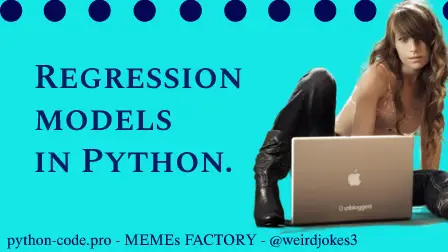Python for Regression.
Python programming language and its libraries combined together form a powerful tool for solving Regression analysis tasks.
Regression study is a predictive modelling method that analyzes the relation between the target or dependent variable and features or independent variables in a dataset.

Python Knowledge Base: Make coding great again.
- Updated:
2025-07-12 by Andrey BRATUS, Senior Data Analyst.
Data Preprocessing Template for Jupiter Notebook or Google Colab.
Support Vector Regression (SVR) in Python.
Decision Tree Regression in Python.
Random Forest Regression model in Python.
Regression models tips and features.
The different types of regression analysis methods are used when the target and independent features described by a linear or non-linear relationships between each other, and the target variable contains continuous values. The regression technique gets used mainly to determine the predictor strength, forecast trends, time series, and sometimes in case of cause & effect relation. Regression analysis is the basic technique to solve the regression problems in machine learning ML using data models. It consists of determining the best fit line, which is a line that passes through all the data points in such a way that distance of the line from each data point is optimal/minimized.
Importing the libraries
import numpy as np
import matplotlib.pyplot as plt
import pandas as pd
Importing the dataset
dataset = pd.read_csv('myData.csv')
X = dataset.iloc[:, :-1].valuest
y = dataset.iloc[:, -1].values
Splitting the dataset into the Training set and Test set
from sklearn.model_selection import train_test_split
X_train, X_test, y_train, y_test = train_test_split(X, y, test_size = 0.2, random_state = 0)
Taking care of missing data
from sklearn.impute import SimpleImputer
imputer = SimpleImputer(missing_values=np.nan, strategy='mean')
imputer.fit(X[:, 1:3])
X[:, 1:3] = imputer.transform(X[:, 1:3])
Encoding categorical data
Encoding the Independent Variable
from sklearn.compose import ColumnTransformer
from sklearn.preprocessing import OneHotEncoder
ct = ColumnTransformer(transformers=[('encoder', OneHotEncoder(), [0])], remainder='passthrough')
X = np.array(ct.fit_transform(X))
Encoding the Dependent Variable
from sklearn.preprocessing import LabelEncoder
le = LabelEncoder()
y = le.fit_transform(y)
Feature Scaling
from sklearn.preprocessing import StandardScaler
sc = StandardScaler()
X_train[:, 3:] = sc.fit_transform(X_train[:, 3:])
X_test[:, 3:] = sc.transform(X_test[:, 3:])
Training the Simple Linear Regression model on the Training set for Jupiter Notebook or Google Colab
from sklearn.linear_model import LinearRegression
regressor = LinearRegression()
regressor.fit(X_train, y_train)
Predicting the Test set results
y_pred = regressor.predict(X_test)
Visualising the Training set results
plt.scatter(X_train, y_train, color = 'red')
plt.plot(X_train, regressor.predict(X_train), color = 'blue')
plt.title('Target vs Feature (Training set)')
plt.xlabel('Feature')
plt.ylabel('Target')
plt.show()
Visualising the Test set results
plt.scatter(X_test, y_test, color = 'red')
plt.plot(X_train, regressor.predict(X_train), color = 'blue')
plt.title('Target vs Feature (Test set)')
plt.xlabel('Feature')
plt.ylabel('Target')
plt.show()
Concatenating predictions and actaul values
np.set_printoptions(precision=2)
print(np.concatenate((y_pred.reshape(len(y_pred),1), y_test.reshape(len(y_test),1)),1))
Training the Polynomial Regression model on the whole dataset
from sklearn.linear_model import LinearRegression
lin_reg = LinearRegression()
lin_reg.fit(X, y)
from sklearn.preprocessing import PolynomialFeatures
poly_reg = PolynomialFeatures(degree = 4)
X_poly = poly_reg.fit_transform(X)
lin_reg_2 = LinearRegression()
lin_reg_2.fit(X_poly, y)
Predicting a new single result with Linear Regression - single feature
lin_reg.predict([[put_here_any_value]])
Predicting a new single result with Polynomial Regression - single feature
lin_reg_2.predict(poly_reg.fit_transform([[put_here_any_value]]))
#Importing the dataset and reshaping target
dataset = pd.read_csv('my_dataset.csv')
X = dataset.iloc[:, :-1].values
y = dataset.iloc[:, -1].values
y = y.reshape(len(y),1)
#Feature Scaling
from sklearn.preprocessing import StandardScaler
sc_X = StandardScaler()
sc_y = StandardScaler()
X = sc_X.fit_transform(X)
y = sc_y.fit_transform(y)
#Training the SVR model on the whole datase (without split)
from sklearn.svm import SVR
regressor = SVR(kernel = 'rbf')
regressor.fit(X, y)
#Predicting a new result (SVR) - single feature
sc_y.inverse_transform(regressor.predict(sc_X.transform([[put_here_any_value]])))
#Visualising the SVR results
plt.scatter(sc_X.inverse_transform(X), sc_y.inverse_transform(y), color = 'red')
plt.plot(sc_X.inverse_transform(X), sc_y.inverse_transform(regressor.predict(X)), color = 'blue')
plt.title('Target vs Feature (SVR)')
plt.xlabel('Feature')
plt.ylabel('Target')
plt.show()
#Importing the dataset
dataset = pd.read_csv('my_dataset.csv')
X = dataset.iloc[:, :-1].values
y = dataset.iloc[:, -1].values
#Training the Decision Tree Regression model on the whole datase (without split)
from sklearn.tree import DecisionTreeRegressor
regressor = DecisionTreeRegressor(random_state = 0)
regressor.fit(X, y)
#Predicting a new result (Decision Tree) - single feature
regressor.predict([[put_here_any_value]])
#Visualising the Decision Tree Regression results in higher resolution
X_grid = np.arange(min(X), max(X), 0.01)
X_grid = X_grid.reshape((len(X_grid), 1))
plt.scatter(X, y, color = 'red')
plt.plot(X_grid, regressor.predict(X_grid), color = 'blue')
plt.title('Target vs Feature (Decision Tree Regression)')
plt.xlabel('Feature')
plt.ylabel('Target')
plt.show()
#The only difference in code from Decision Tree Regression above is Training the Random Forest Regression model,
# on the whole dataset (without split) in this example
from sklearn.ensemble import RandomForestRegressor
regressor = RandomForestRegressor(n_estimators = 10, random_state = 0)
regressor.fit(X, y)
Model: Linear Regression.
Pros: Works on any size of dataset, gives informations about relevance of features.
Cons: Linear Regression Assumptions.
Model: Polynomial Regression.
Pros: Works on any size of dataset, works very well on non linear problems.
Cons: Needed to choose the right polynomial degree for a good bias/variance tradeoff.
Model: SVR.
Pros: Easily adaptable, works very well on non linear problems, not biased by outliers.
Cons: Compulsory to apply feature scaling, difficult interpretations.
Model: Decision Tree Regression.
Pros: Interpretability, no need for feature scaling, works on both linear / nonlinear problems.
Cons: Poor results on too small datasets, overfitting can easily occur.
Model: Random Forest Regression.
Pros: Powerful and accurate, good performance on many problems, including non linear.
Cons: No interpretability, overfitting can easily occur, needed to choose the number of trees.
